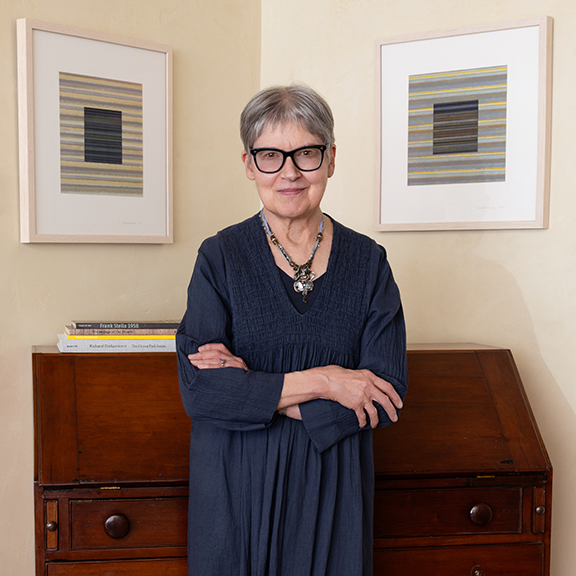A Ranching Community: Its Life and Its People: A Three Part Series
by Thomas Yeomans
This article originally appeared in the Summer 2025 issue of Art with Altitude.
Part II—EARLE HAMMOND had worked outdoors all his life, and his sixty years had left his sinewy body lean and slightly bent. His hands were big and gnarled, and he had the habit of scratching the backs of them while he talked. The skin on his face was like tanned leather, but it turned into soft white at the neckline. His clear-blue eyes saw everything, and there was always a quiet smile waiting at the edge of his mouth. He had always lived in the West or Middle West, and was proud of it. His parents moved west just after the pioneers, and when he was a boy, he remembered that they had to flee their homestead several times because of Indian raids. When he was fourteen years old, he drove a herd of a hundred horses some two hundred miles across Montana all by himself. His life has been one of independence and self-sufficiency, and he loves now to sit, and look back over it, telling me stories of his youth as a homesteader and as a cowhand with nothing but his saddle, his clothes, and his pay. His education has been the law of nature and the wilderness, and he has learned his lesson well.
When he married his first wife they took 160 acres in the wilderness of Montana, cleared as much as they needed, and set up a homestead. The nearest town was some 65 miles away, and they traveled there on horseback twice a year. They raised all the food they ate, lived in a house of logs, and rarely saw other people. Their life was isolated, but very full and happy.
Later, when they moved to a more populated place, they had more friends, and Earle tells of community parties at different friends’ houses on long winter evenings. The town was only twelve miles away then, and they had a buggy, but they still lived from the earth, seeking out their simple existence by their own labor. Earle
fought in France during the first world war, but did not “take much stock” in Europe and the East, and was very glad to get away from the crowds of people, not to mention the war, and to go back to his former life.
When his first wife died, he married an Iowa girl, Sue, and settled down to farming in Iowa. This was a change, but he was still happy for being “west of the Mississippi” and working with his hands. His life has been one of labor and little else, but he is very content with it. He says of his life “Well, I’ve worked all my life, and though I don’t really have to work now, I wouldn’t feel right not doin’ something.” In reality, he is a prosperous farmer, but work is so much in his blood that he keeps on. He figures that if he keeps working, then, when he can’t, he won’t have to spend much time doing nothing, for all will soon end. At present he owns two farms in Iowa which his brothers-in-law run, and he has come west again to work as an irrigator.
When I first met him, he seemed to me to be hard and old fashioned. He treated horses roughly it seemed to me, and was very suspicious of me, an Easterner. Earle considered everyone who was not native, a “furiner” and he used to point them out scornfully as they drove by the field we were working in. This made me wonder at first just where I stood. He had never been east of the Mississippi of his own accord, and had no desire to see the East. It was too crowded, and full of cars. All he wanted to do was to stay in the country, working and fishing.
For the first week we went out together to irrigate before breakfast, and he made sure that I knew how green I was, and how useless my education was. “Nearest I’ve ever been to a college is drivin’ through it” he once said, and I quickly saw that practical skill was what was important to him. I had to prove myself to him with my irrigating shovel, not with my mind. What he has learned, he has learned from experience and many long years of doing, not from books. He has lived a stone’s throw from the wilderness all his life, and his weather-beaten face and clear eyes reflect this wearing, but defiant life. His age sits well on him, and he is still as nimble as we young ones. Again and again he put us to shame with the amount of work he did.
When he got to know me, and respect me for what I could do, he took me in completely, and I became almost a son. When, after a long absence, I returned to the fields to irrigate with him, he received me with the joy of a father welcoming his boy. He watched out for me, and through his stories taught me what he knew and loved. He loved to recall “When I was a boy …,” and I used to spend long hours listening. What I found most exciting about him though was his contentment with his life. Once he said to me, “Well, I guess I am pretty satisfied with my life,” and there are all too few people in this day and age who can say that and mean it as he did. Here is a man who, within the framework given him, has discovered a life he really loves, and who would have no other. It has been a simple existence, full of hard work, and lacking in most of the luxuries we are inclined to call necessities, but it is a life anyone could admire, and one of which he is very proud.
Before Earle went to work for John Fetcher, everyone told him “Don’t work for Fetcher. He can’t keep his men. He works them too hard.” Earle once said “I ain’t ascared of no man.” So he went to work for John anyway, and was happy he had. Earle used to say to me, “Tom, just remember, you can’t do it all in a day,” and once said, “I only got so much time to live, and I’ll be damned if I’m going to spend all of it rushing around working. A man’s got to have his rest too.” It was not that they did not like their work, but they did not have this tremendous drive toward success and improvement. They were perfectly content to go on doing what they had always done, no matter how inefficient it was. They never really questioned the efficiency of a method, but were quite satisfied with it because it was familiar. When they worked, they worked hard, for they always had, but they were just as willing to stop if the occasion arose, and talk awhile. In the many times when I would go off to work with Earle, if we met someone, we would always stop, squat down on the ground, and talk over the affairs of the day while rolling cigarettes or chewing grass. Sometimes we spent as much as half hour in this way, and then, when we were done talking, we would move on. When lunchtime came, we stopped to cook our lunch, and usually took a little snooze afterwards. The pace was easy going, and though we got things done, there was never a sense of frantic hurry.
There is much to be envied in the city but, as in Good Fortune, the country folk claim moral superiority and look down upon the decadent, inept Easterners. Practical skill and common sense are what a man is valued for in this community.
Elevate the Arts: If you are new to town, take the time to get to know the locals, their values and beliefs. Through conversation, compassion and respect, the Yampa Valley will retain the beauty that has drawn us all here. TY




